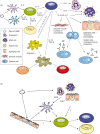Review series on helminths, immune modulation and the hygiene hypothesis: immunity against helminths and immunological phenomena in modern human populations: coevolutionary legacies?
- PMID: 19120495
- PMCID: PMC2632709
- DOI: 10.1111/j.1365-2567.2008.03010.x
Review series on helminths, immune modulation and the hygiene hypothesis: immunity against helminths and immunological phenomena in modern human populations: coevolutionary legacies?
Erratum in
- Immunology. 2009 Mar;126(3):446
Abstract
Although the molecules and cells involved in triggering immune responses against parasitic worms (helminths) remain enigmatic, research has continued to implicate expansions of T-helper type 2 (Th2) cells and regulatory T-helper (T(reg)) cells as a characteristic response to these organisms. An intimate association has also emerged between Th2 responses and wound-healing functions. As helminth infections in humans are associated with a strong Th2/T(reg) immunoregulatory footprint (often termed a 'modified Th2' response), plausible links have been made to increased susceptibility to microbial pathogens in helminth-infected populations in the tropics and to the breakdowns in immunological control (allergy and autoimmunity) that are increasing in frequency in helminth-free developed countries. Removal of helminths and their anti-inflammatory influence may also have hazards for populations exposed to infectious agents, such as malaria and influenza, whose worst effects are mediated by excessive inflammatory reactions. The patterns seen in the control of helminth immunity are discussed from an evolutionary perspective. Whilst an inability to correctly regulate the immune system in the absence of helminth infection might seem highly counter-adaptive, the very ancient and pervasive relationship between vertebrates and helminths supports a view that immunological control networks have been selected to function within the context of a modified Th2 environment. The absence of immunoregulatory stimuli from helminths may therefore uncover maladaptations that were not previously exposed to selection.
Figures



References
-
- Maizels RM, Yazdanbakhsh M. Immune regulation by helminth parasites: cellular and molecular mechanisms. Nat Rev Immunol. 2003;3:733–44. - PubMed
-
- Anderson RC. Why do fish have so few roundworm (nematode) parasites? Environ Biol Fishes. 1996;46:1–5.
-
- Littlewood DTJ, Rohde K, Clough KA. The interrelationships of all major groups of Platyhelminthes: phylogenetic evidence from morphology and molecules. Biol J Linn Soc Lond. 1999;66:75–114.
-
- Clark WC. Origins of the parasitic habit in the Nematoda. Int J Parasitol. 1994;24:1117–29. - PubMed
Publication types
MeSH terms
Grants and funding
LinkOut - more resources
Full Text Sources
Other Literature Sources
Research Materials

